What is Vvoa file extension
.Vvoa file extension is a file extension that is used by the 264th version of the STOP (Djvu) ransomware. Like other ransomware, Vvoa virus is created to encrypt the victim’s files, and then demand a ransom for decrypting them. Fortunately, a group of security researchers created a free decryptor. Vvoa File Decrypt Tool is a free software that, in some cases, helps ransomware victims to decrypt .vvoa files. In addition to the decryptor, there are several more methods, each of which can help restore the contents of encrypted files. Read more about this, as well as how to remove Vvoa ransomware virus and protect your computer from such ransomware below.
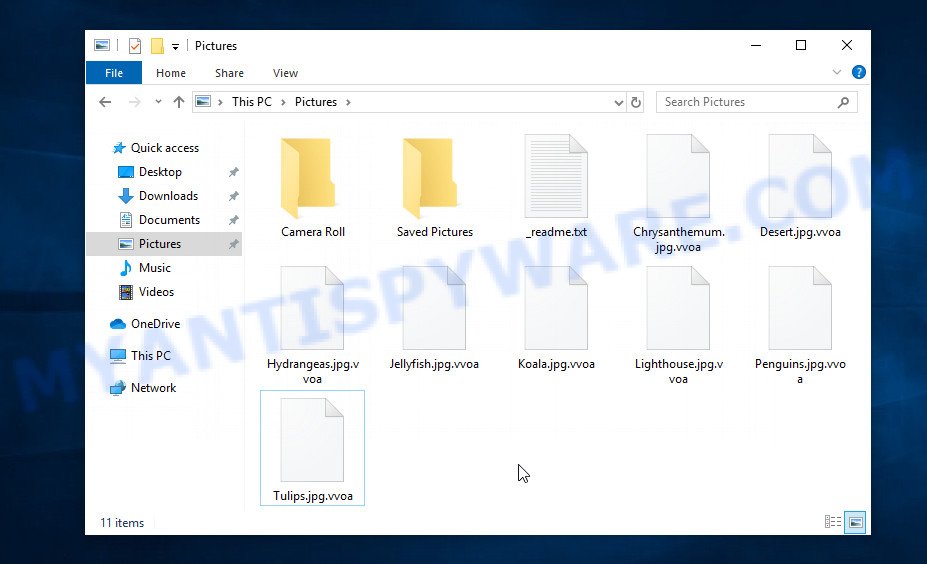
Screenshot of files encrypted by Vvoa virus (‘.vvoa’ file extension)
What is Vvoa ransomware virus
Vvoa ransomware is new variant of the STOP (Djvu) ransomware. According to security researchers, this version is not much different from previous versions of STOP ransomware, such as Agho and Vpsh, which were discovered earlier. The ransomware virus is spread by websites offering to download activators, freeware, key generators, cracked games, torrents and so on.
Upon execution, Vvoa ransomware creates a folder in the Windows system directory where it places a copy of itself and changes some Windows settings so that it starts up every time the computer is restarted or turned on. The virus collects information about the victim’s computer and then tries to establish a connection with its command server (C&C). If the connection has been established, then it sends information about the infected computer to the server, and in response receives the encryption key (the so-called ‘online key’) and additional commands and malware that must be executed on the victim’s computer. If the virus could not establish a connection with its command server, then it uses a fixed key (the so-called ‘offline key’).

Vvoa ransomware virus encrypts files using a strong encryption algorithm and a key (‘offline key’ or ‘online key’, as described above). The virus tries to encrypt as many files as possible, for this it only encrypts the first 154kb of the contents of each file and thus significantly speeds up the encryption process. Vvoa has the ability to encrypt files on all drives connected to the computer: internal hard drives, flash USB disks, network storage, and so on. It skips without encryption: files located in the Windows system directories, files with the extension .ini, .bat, .dll, .lnk, .sys and files with the name ‘_readme.txt’. The remaining files located on the victim’s computer can be encrypted. For example, the following file types may be the target of ransomware attack:
.indd, .layout, .mdbackup, .xlgc, .jpeg, .cr2, .arch00, .xxx, .wbmp, .wpt, .docm, .wpl, .mddata, .ztmp, .crt, .vfs0, .mov, .wps, .big, .hvpl, .sr2, .cas, .1, .qic, .wpe, .hkx, .hplg, .crw, .snx, .wm, .t13, .wdp, .sql, .xdb, .mlx, .yml, .ods, .eps, .pptm, .xml, .wn, .dba, .pkpass, .bsa, .vpk, .svg, .w3x, .desc, .p7b, .3ds, .yal, .slm, .wmv, .fsh, .syncdb, .flv, .raw, .sis, .m2, .xls, .m4a, .wri, .der, .upk, .zdc, .xpm, .mdb, .p12, .pfx, .cer, .dcr, .x, .ibank, .tor, .wpw, .mef, .wp4, .xlsx, .webdoc, .wpd, .orf, .mdf, .xlsb, .ppt, .3fr, .xbdoc, .xld, .wmf, .bkf, .dazip, .m3u, .arw, .apk, .ybk, .pdd, .zip, .zif, .nrw, .bc7, .wcf, .dxg, .x3f, .rar, .gho, .mrwref, .avi, .rwl, .hkdb, .wsh, .iwd, .wdb, .rtf, .sidd, .blob, .docx, .mpqge, .dmp, .xmmap, .dwg, .xlk, .jpe, .itdb, .dng, .2bp, .xy3, .wot, .esm, .pdf, .kdb, .psk, .ysp, .rofl, .bay, .ltx, .png, .mp4, .bc6, .3dm, .wpa, .wbm, .css, .wsc, .wp5, .icxs, .ws, .wbc, .x3f, .sav, .itm, .ai, .wp7, .iwi, .wire, .zdb, .d3dbsp, .x3d, .wsd, .sie, .webp, .7z, .wgz, .ncf, .wpg, .t12, .doc, .pef, .ptx, .pak, .vpp_pc, .xar, .rgss3a, .py, .erf, .itl, .lbf, .sum, .wma, .db0, .ntl, .das, .wmd, .sid, .zabw, .zip, .p7c, .raf, .wpb, .xbplate, .wbk, .rim, .tax, .js, .wb2, .odp, .wp, .vdf, .lvl, .mcmeta, .forge, .fpk, .xf, .vcf, .bik, .kf, .xlsm, .lrf
Vvoa ransomware encrypts file-by-file. Each file that has been encrypted will be renamed, the .vvoa extension will be added at the end of its name. Thus, it marks all encrypted files. In every directory where there is at least one encrypted file, the virus places a file named ‘_readme.txt’. The file contains a message from Vvoa authors. An example of the contents of this file is given below.
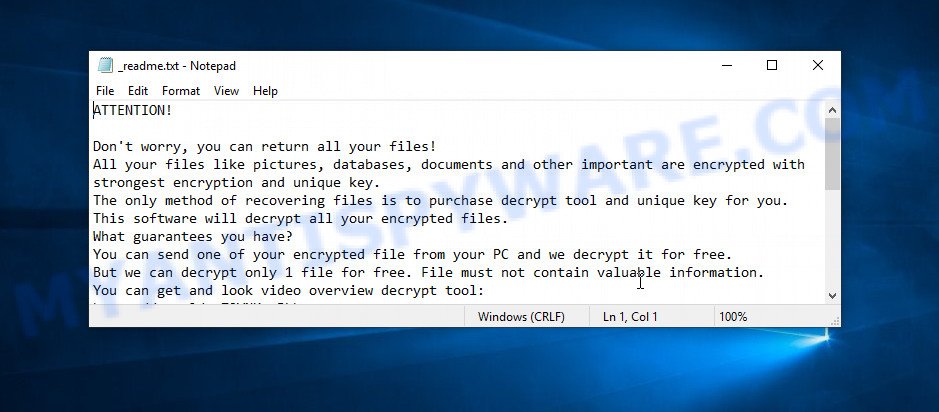
Screenshot of the contents of ‘_readme.txt’ file (Vvoa ransom note)
This message says that all files on the computer are encrypted and the only way to decrypt them is to purchase a key and a decryptor from the authors of Vvoa virus. That is, criminals demand a ransom for unlocking the victim’s files. The size of the ransom is $980, but if the victim is ready to pay the ransom within 72 hours, then its size is halved to $490. Attackers offer victims to verify that encrypted files can be decrypted. To do this, the victim must send them a small file to one of the email addresses specified in the ‘_readme.txt’ file. Of course, it is obvious that a single decrypted file cannot guarantee that after paying the ransom, the criminals will provide the victim with a working key and decryptor.
The presented in the Vvoa ransom note:
ATTENTION!
Don’t worry, you can return all your files!
All your files like photos, databases, documents and other important are encrypted with strongest encryption and unique key.
The only method of recovering files is to purchase decrypt tool and unique key for you.
This software will decrypt all your encrypted files.
What guarantees you have?
You can send one of your encrypted file from your PC and we decrypt it for free.
But we can decrypt only 1 file for free. File must not contain valuable information.
You can get and look video overview decrypt tool:
https://we.tl/t-Dz5odBd07y
Price of private key and decrypt software is $980.
Discount 50% available if you contact us first 72 hours, that’s price for you is $490.
Please note that you’ll never restore your data without payment.
Check your e-mail “Spam” or “Junk” folder if you don’t get answer more than 6 hours.To get this software you need write on our e-mail:
helpmanager@mail.chReserve e-mail address to contact us:
restoremanager@airmail.ccYour personal ID:
Threat Summary
| Name | Vvoa ransomware, Vvoa File Virus |
| Type | Crypto malware, Crypto virus, File locker, Ransomware, Filecoder |
| Encrypted files extension | .vvoa |
| Ransom note | _readme.txt |
| Contact | helpmanager@mail.ch, restoremanager@airmail.cc |
| Ransom amount | $980/$490 in Bitcoins |
| Detection Names | Trojan.Ransom.Stop, TrojanDropper:Win32/Kryptik, Win32:DropperX-gen [Drp], W32/Trojan.SOTY-1431, A Variant Of Win32/Kryptik.HHKS, Virus.Win32.Cryptor, Trojan.Malware.300983.susgen, Trojan.MalPack.GS, Trojan:Win32/Glupteba!ml, TrojanSpy.Win32.GLUPTEBA.USMANKC20 |
| Symptoms | Cannot open files stored on the computer. All of your documents, photos and music have a odd file extension appended to the filenames. Your file directories contain a ‘ransom note’ file that is usually a .html, .jpg or .txt file. Desktop wallpaper is changed to the ransom note. |
| Distribution methods | Malicious e-mail spam. Exploit kits (cybercriminals use ransomware packaged in an ‘exploit kit’ that can find a vulnerability in Web browser, PDF reader, Adobe Flash Player, Microsoft Windows operating system). Social media posts (they can be used to force users to download malicious software with a built-in ransomware downloader or click a misleading link). USB key and other removable media. |
| Removal | Vvoa ransomware removal guide |
| Decryption | Vvoa File Decrypt Tool |
How to remove Vvoa ransomware virus, Recover, Decrypt .vvoa files
Security researchers confirm the words of the Vvoa authors. All files with the extension ‘.vvoa’ are encrypted and thus cannot be read and used. The only way to decrypt them is to use the key and the decryptor. Fortunately, there is some good news. As we already reported above, Vvoa virus belongs to STOP ransomware family, which means that you can use the free decryptor created by Emsisoft to decrypt the encrypted files. Even if the decryptor does not help, there are some alternative ways that can help restore the contents of the encrypted files. To learn more about decrypting files, simply scroll down to section ‘How to decrypt .vvoa files’. Read the entire manual carefully. To make it easier for you to follow the instructions, we recommend that you print it or open it on your smartphone.
- How to remove Vvoa ransomware virus
- How to decrypt .vvoa files
- How to restore .vvoa files
- How to protect your PC from Vvoa ransomware
How to remove Vvoa ransomware virus
Before you start decrypting or recovering .vvoa files, you need to remove the Vvoa autostart entries. This must be done since otherwise the ransomware may re-encrypt the restored files. You can stop the ransomware from working, as it is not difficult to do. Another option is to perform a full system scan using free malware removal tools capable of detecting and removing ransomware infection.
It is very important to scan the computer for malware, as security researchers found that spyware could be installed on the infected computer along with the Vvoa ransomware. Spyware is a very dangerous security threat as it is designed to steal the user’s personal information such as passwords, logins, contact details, etc. If you have any difficulty removing the Vvoa virus, then let us know in the comments, we will try to help you.
To remove Vvoa ransomware, follow the steps below:
- Kill Vvoa ransomware
- Disable Vvoa ransomware Start-Up
- Delete Vvoa ransomware Task
- Delete Vvoa virus file
- Scan computer for malware
Kill Vvoa ransomware
Press CTRL, ALT, DEL keys together.

Click Task Manager. Select the “Processes” tab, look for something suspicious that is the Vvoa ransomware then right-click it and select “End Task” or “End Process” option. If your Task Manager does not open or the Windows reports “Task manager has been disabled by your administrator”, then follow the guide: How to Fix Task manager has been disabled by your administrator.
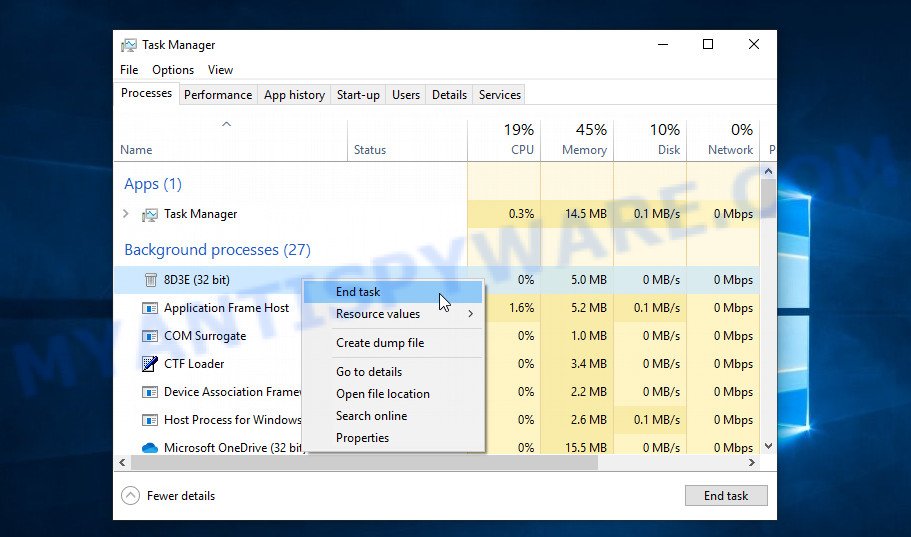
It is not difficult to detect a process related to the Vvoa ransomware. When looking for a malicious process, pay attention to the process icon and its name. Most often, this ransomware has a process name in the following format: 4-characters.tmp.exe or 4-characters.exe. For example: 7533.tmp.exe, A4b1.exe, CD15.tmp.exe, 19b2.exe. The process name can also contain “(32 bit)”. If you do not find a process with a similar name in the list of processes, then most likely the Vvoa ransomware has finished working. But keep in mind, if you do not remove the ransomware autostart entries, as demonstrated below, and do not delete its file, then after a while it may start again, and if it finds unencrypted files, immediately encrypt them.
Disable Vvoa ransomware Start-Up
Select the “Start-Up” tab, look for something similar to the one shown in the example below, right click to it and select Disable.
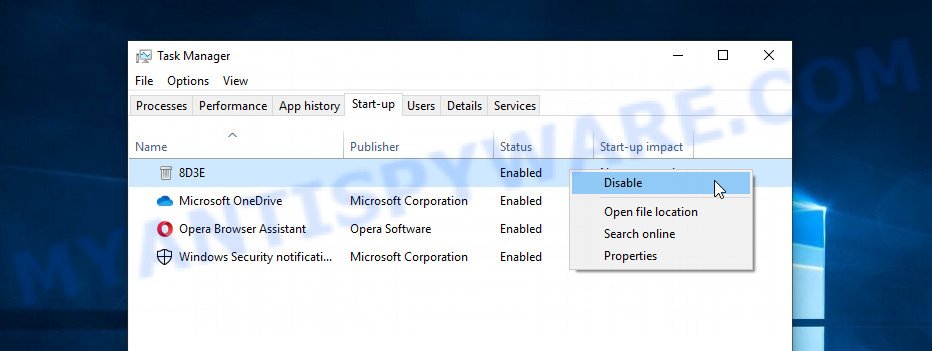
Close Task Manager.
Delete Vvoa ransomware Task
Type “Task Scheduler” in the search bar. Click Task Scheduler app in the search results. Click “Task Scheduler Library” in the left panel. On the right panel, right-click to “Time Trigger Task” and select Delete.
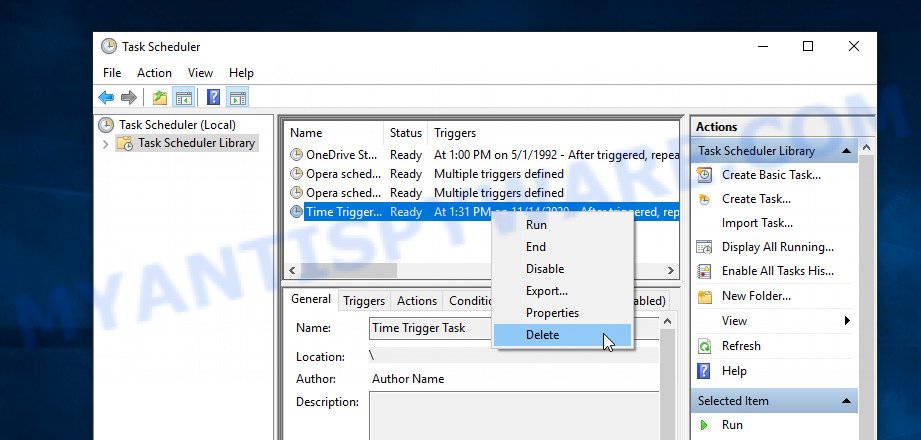
Close Task Scheduler.
Delete Vvoa virus file
Run Task Manager and select the “Start-Up” tab. Right click to the Vvoa ransomware Start-Up entry and select Open File Location as shown below.
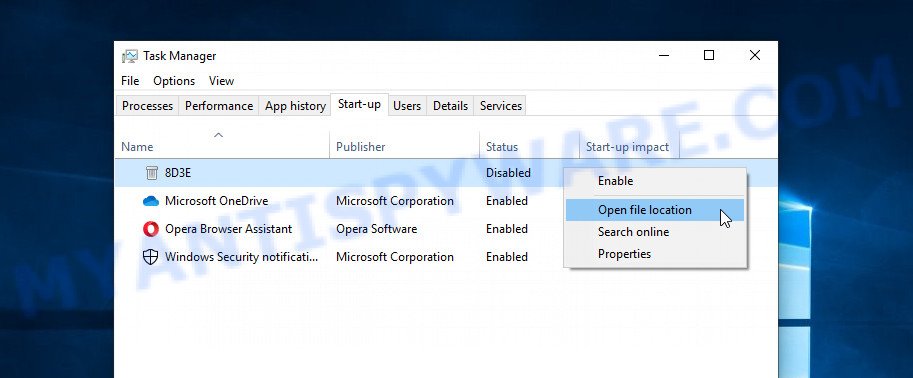
A directory containing one file will open in front of you, this file is the Vvoa ransomware. It needs to be removed. If you try to delete it immediately, then you will not succeed, since this file is protected from deletion.
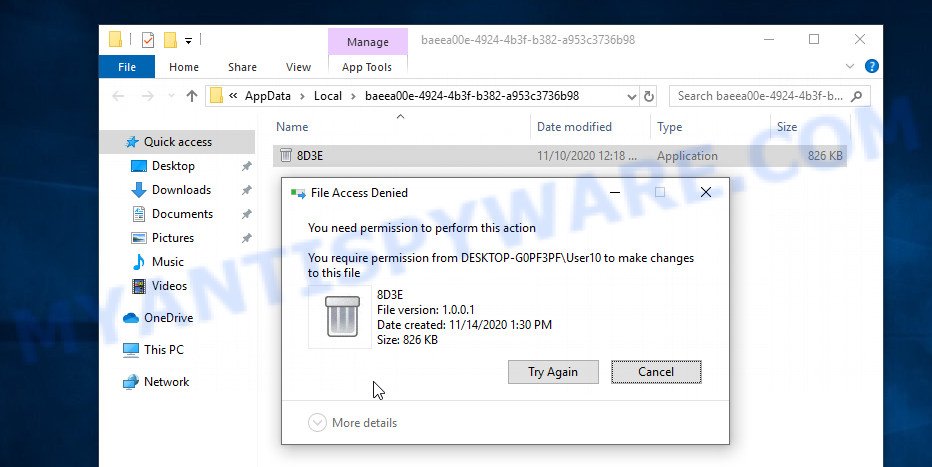
To delete this file, you need to do the following. Right-click on the file, select Properties. In the window that opens, select Security tab. Next, click the Advanced button below. A window will open as shown in the following example.
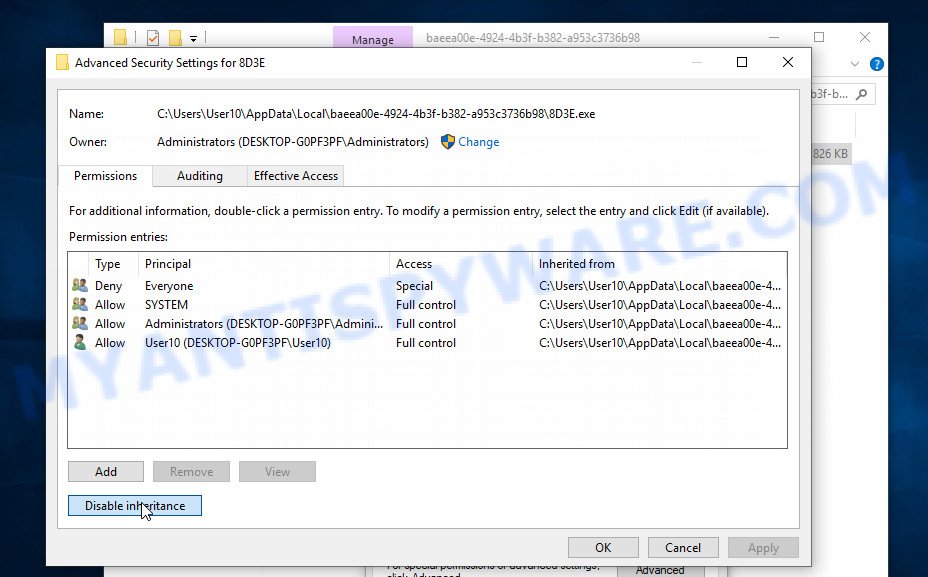
Click Disable inheritance. In the Block inheritance dialog box that opens, select the first item (Convert inherited permissions…) as shown below.
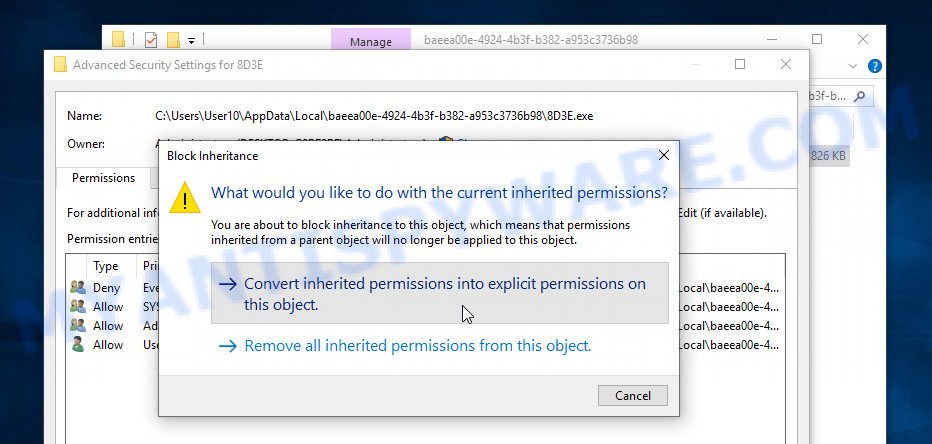
In the Permission entries list, select “Deny Everyone”, click Remove button and then OK. Close the file properties window. You should now be able to remove the Vvoa ransomware File. Right-click on the file and select Delete.
Scan computer for malware
Zemana Anti-Malware (ZAM) is a malware scanner that is very useful for detecting and deleting Vvoa ransomware virus. The steps below will explain how to download, install, and use Zemana to scan your personal computer and remove crypto malware, spyware, trojans, malicious software, adware software, worms and other security threats for free.
Visit the following page to download Zemana Anti-Malware installer named Zemana.AntiMalware.Setup on your personal computer. Save it to your Desktop.
164780 downloads
Author: Zemana Ltd
Category: Security tools
Update: July 16, 2019
Start the installer after it has been downloaded successfully and then follow the prompts to install this tool on your device.

During installation you can change certain settings, but we advise you don’t make any changes to default settings.
When install is done, this malware removal tool will automatically start and update itself. You will see its main window such as the one below.

Now click the “Scan” button to perform a system scan with this utility for the Vvoa ransomware virus, other kinds of potential threats like malicious software and trojans. While the tool is scanning, you can see how many objects and files has already scanned.

After Zemana Anti Malware completes the scan, you will be displayed the list of all found security threats on your PC. When you are ready, click “Next” button.

The Zemana Anti-Malware (ZAM) will remove Vvoa crypto malware related folders,files and registry keys. When the task is complete, you can be prompted to reboot your computer to make the change take effect.
In order to be 100% sure that the computer no longer has the Vvoa ransomware virus, we recommend using Kaspersky virus removal tool (KVRT). It is free and easy to use. It can scan and delete ransomware, spyware, potentially unwanted software, worms, trojans, adware and other malicious software. KVRT is powerful enough to find and delete malicious registry entries and files that are hidden on the device.
Download Kaspersky virus removal tool on your Windows Desktop from the link below.
129228 downloads
Author: Kaspersky® lab
Category: Security tools
Update: March 5, 2018
After the downloading process is done, double-click on the Kaspersky virus removal tool icon. Once initialization procedure is done, you will see the KVRT screen as displayed on the screen below.

Click Change Parameters and set a check near all your drives. Press OK to close the Parameters window. Next click Start scan button to locate Vvoa crypto virus and other known infections. While the Kaspersky virus removal tool is scanning, you can see how many objects it has identified either as being malicious software.

Once Kaspersky virus removal tool completes the scan, KVRT will produce a list of unwanted apps and ransomware virus as shown below.

In order to delete all threats, simply press on Continue to start a cleaning process.
How to decrypt .vvoa files
As we already reported above, files with .vvoa extension are files that have been encrypted by Vvoa ransomware virus. Their contents will remain locked until decrypted using the decryptor and the key. Fortunately, there is a free decryptor that can decrypt .vvoa files. Below we provide instructions on where to download and how to use Vvoa File Decrypt Tool.

Vvoa File Decrypt Tool (STOP Djvu decryptor)
To decrypt .vvoa files, use Vvoa File Decrypt Tool
- Download Vvoa File Decrypt Tool from the following link.
STOP Djvu decryptor - Scroll down to ‘New Djvu ransomware’ section.
- Click the download link and save the decrypt_STOPDjvu.exe file to your desktop.
- Run decrypt_STOPDjvu.exe, read the license terms and instructions.
- On the ‘Decryptor’ tab, using the ‘Add a folder’ button, add the directory or disk where the encrypted files are located.
- Click the ‘Decrypt’ button.
Vvoa File Decrypt Tool is a free software that can decrypt the encrypted files only in some cases, when the files were encrypted with an ‘offline key’. If the files were encrypted with an ‘online key’, then they cannot be decrypted. The reason for this is that the decryption key is in the hands of criminals and this key can not be determined. This does not mean that if your files are encrypted with an online key, then their contents are lost forever. Fortunately, there are several ways to recover encrypted files. These methods do not involve the use of decryption and therefore can be used in any case, no matter what key the ransomware used to encrypt files.
How to find out which key was used to encrypt files
Below we show two ways to help you determine what type of key was used to encrypt your files. This is very important, since the type of key determines whether it is possible to decrypt .vvoa files. We recommend using the second method, as it is more accurate.
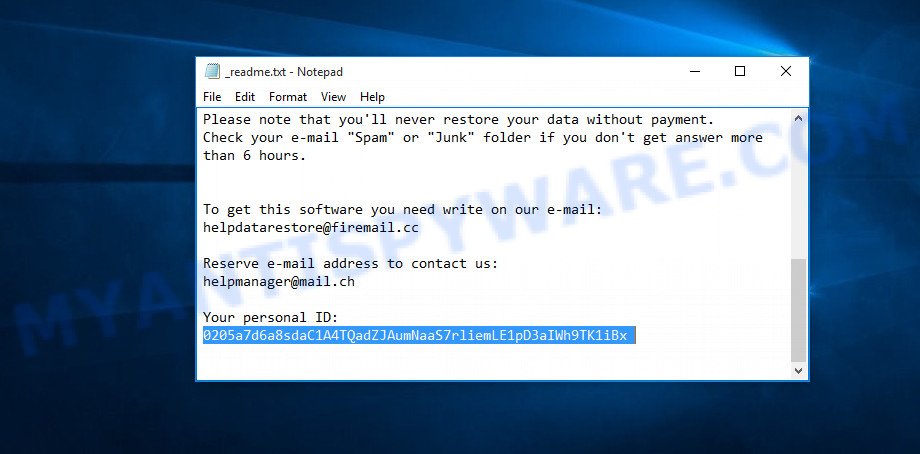
Personal ID is highlighted here
Find out the type of key using ‘_readme.txt’ file
- Open the ransom demand message (‘_readme.txt’ file).
- Scroll down to the end of the file.
- There you will see a line with the text ‘Your personal ID’.
- Below is a line of characters – this is your personal id.
Find out the type of key using ‘PersonalID.txt’ file
- Open disk C.
- Open directory ‘SystemID’.
- Open file named ‘PersonalID.txt’. This file lists ‘Personal ID’s that match the keys that the Vvoa ransomware used to encrypt files.
The ‘Personal ID’ is not a key, it is an identifier related to a key that was used to encrypt files. If the ID ends with ‘t1’, then the files are encrypted with an offline key. If the ID does not end with ‘t1’, Vvoa ransomware virus used an online key. If you could not figure out how to determine which key was used to encrypt files, then we can help. Just write a request here or in the comments below.
Vvoa File Decrypt Tool : “No key for New Variant online ID”

If, when you try to decrypt .vvoa files, Vvoa File Decrypt Tool reports:
No key for New Variant online ID: *
Notice: this ID appears to be an online ID, decryption is impossible
It means that your files are encrypted with an ‘online key’ and their decryption is impossible, since only the Vvoa authors have the key necessary for decryption. In this case, you need to use alternative methods listed below to restore the contents of encrypted files.
Vvoa File Decrypt Tool : “No key for New Variant offline ID”

If, during decryption of .vvoa files, Vvoa File Decrypt Tool reports:
No key for New Variant offline ID: *t1
Notice: this ID appears be an offline ID, decryption MAY be possible in the future.
It means the following: your files are encrypted with an ‘offline key’, but the key itself has not yet been obtained by security researchers, in this case, you need to be patient and wait a while, in addition, you can also use alternative ways for recovering encrypted data.
If for some reason you were unable to decrypt the encrypted files, then We recommend to follow the news on our Facebook or YouTube channels. So you ‘ll know right away that it ‘s possible to decrypt .vvoa files.
This video step-by-step guide will demonstrate How to remove Vvoa ransomware, Decrypt/Recover .vvoa files.
How to restore .vvoa files
As we mentioned above, in addition to using the Vvoa File Decrypt Tool, there are several more methods for recovering encrypted files. These methods do not require the use of a decryptor and a key, and therefore are suitable for all cases when the ransomware used an online key, and for the case when the ransomware used an offline key. It is very important to check your computer for malware before you try to recover encrypted files. You must be 100% sure that Vvoa ransomware virus is completely removed. To scan your computer for ransomware, use free malware removal tools.
Restore .vvoa files with ShadowExplorer
The Microsoft Windows has a feature called ‘Shadow Volume Copies’ that can help you to recover .vvoa files encrypted by the ransomware. A small tool called ShadowExplorer will allow you to easily access the Shadow copies and restore the encrypted files to their original state. Unfortunately, the ransomware can delete these Shadow copies before it starts encrypting files. Therefore, if ShadowExplorer did not help you, then try another method, which is given below.
Installing the ShadowExplorer is simple. First you will need to download ShadowExplorer on your PC from the link below.
439424 downloads
Author: ShadowExplorer.com
Category: Security tools
Update: September 15, 2019
When the downloading process is done, open a directory in which you saved it. Right click to ShadowExplorer-0.9-portable and select Extract all. Follow the prompts. Next please open the ShadowExplorerPortable folder like below.

Start the ShadowExplorer utility and then choose the disk (1) and the date (2) that you wish to restore the shadow copy of file(s) encrypted by the Vvoa ransomware virus as shown on the screen below.

Now navigate to the file or folder that you wish to recover. When ready right-click on it and click ‘Export’ button such as the one below.

This video step-by-step guide will demonstrate How to recover encrypted files using Shadow Explorer.
Recover .vvoa files with PhotoRec
The last chance to restore encrypted files to their original state is using data recovery tools. We recommend a program called PhotoRec. It has all the necessary functions to restore the contents of encrypted files. It helped many victims recover data when it seemed like there was no more hope.
Download PhotoRec on your Windows Desktop from the following link.
When the download is done, open a directory in which you saved it. Right click to testdisk-7.0.win and choose Extract all. Follow the prompts. Next please open the testdisk-7.0 folder as displayed below.

Double click on qphotorec_win to run PhotoRec for Microsoft Windows. It’ll display a screen as shown below.

Select a drive to recover such as the one below.

You will see a list of available partitions. Select a partition that holds encrypted photos, documents and music as displayed below.

Press File Formats button and specify file types to restore. You can to enable or disable the recovery of certain file types. When this is done, click OK button.

Next, click Browse button to select where recovered photos, documents and music should be written, then click Search. We strongly recommend that you save the recovered files to an external drive.

Count of recovered files is updated in real time. All restored files are written in a folder that you have selected on the previous step. You can to access the files even if the recovery process is not finished.
When the restore is done, click on Quit button. Next, open the directory where recovered documents, photos and music are stored. You will see a contents as displayed in the following example.

All restored photos, documents and music are written in recup_dir.1, recup_dir.2 … sub-directories. If you are looking for a specific file, then you can to sort your restored files by extension and/or date/time.
This video step-by-step guide will demonstrate How to recover encrypted files using PhotoRec.
How to protect your PC from Vvoa ransomware
Most antivirus programs already have built-in protection system against the ransomware. Therefore, if your PC does not have an antivirus program, make sure you install it. As an extra protection, run the HitmanPro.Alert. All-in-all, HitmanPro.Alert is a fantastic utility to protect your system from any ransomware. If ransomware is detected, then HitmanPro.Alert automatically neutralizes malware and restores the encrypted files. HitmanPro.Alert is compatible with all versions of MS Windows operating system from MS Windows XP to Windows 10.
First, click the link below, then press the ‘Download’ button in order to download the latest version of HitmanPro Alert.
Once the download is done, open the folder in which you saved it. You will see an icon like below.

Double click the HitmanPro Alert desktop icon. Once the utility is launched, you will be displayed a window where you can choose a level of protection, as on the image below.

Now click the Install button to activate the protection.
To sum up
This guide was created to help all victims of Vvoa ransomware virus. We tried to give answers to the following questions: how to remove ransomware; how to decrypt .vvoa files; how to recover files, if the Vvoa File Decrypt tool does not help; what is an online key and what is an offline key. We hope that the information presented in this manual has helped you.
If you have questions, then write to us, leaving a comment below. If you need more help with Vvoa related issues, go to here.























An unfortunate co-incident happen while the same day 14th November 2020 whole this article posted my PC windows 10 has been under attack by .vvoa ransomware. I’m a poor graduate student from Bangladesh and I have nothing to pay for those attacker(s), but only can pray to God to guide them in right path for living an honest life. My all research articles and papers are now into grave danger. I need dire help , sir to uphold my career from being destroyed. Please help me , Sir.
My personal ID: 0264ergagAT69FNm5lcotGjI31lK0LfhwJsLRy8zZWUS9N3t . I’ve followed all nearly all procedures here especially through Zemana Anti-Malware (ZAM) & Kasper-sky I’ve deleted several Trojans or attacking files. But, my .vvoa files are not recovering by Emsi softwares . What shall I do , sir ? Recovery of those are most urgent for my career sir. Please help me for God’s shake.
The “0264ergagAT69FNm5lcotGjI31lK0LfhwJsLRy8zZWUS9N3t” ID is related to an online key, so files cannot be decrypted. Try to restore the contents of encrypted files using the steps linked below: How to recover encrypted files.
Just today my file went to vvao mode and i had no clue how to get it back . Also i deleted my read me file i thought its better to delete that without even reading it so i dont have that file now . i dont know now how to decrypt my files its was my only work.
Ps: Esmi make my system slow its not a good option
0264erga7aroVU8PxkAWqgUyZH4zb4InzgSmAVbyeP3y0sBV
How about the above ID?
The “0264erga7aroVU8PxkAWqgUyZH4zb4InzgSmAVbyeP3y0sBV” ID is related to an online key, so files cannot be decrypted. Try to restore the contents of encrypted files using the steps linked below: How to recover encrypted files.
please help me
Please How to remove stone ransomware, Decrypt .stone files.
Use free malware rmeoval tools https://www.myantispyware.com/2018/04/23/best-free-malware-removal-tools/ to remove stone ransomware, then use the instructions below to recover encrypted files https://www.myantispyware.com/2019/12/04/how-to-recover-encrypted-files-ransomware-file-recovery/